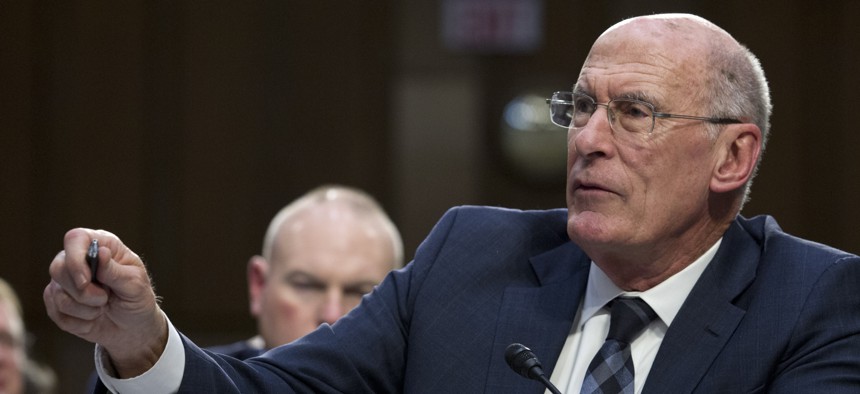
Director of National Intelligence Daniel Coats testifies before the Senate Intelligence Committee on Capitol Hill in Washington Tuesday, Jan. 29, 2019. ap photo/jose luis magana
Trump’s Cyber Strategy Is Far Too Optimistic
The director of national intelligence’s threat assessment exposes two of its pillars as convenient fictions.
I used to think we didn’t have enough strategic documents guiding U.S. cyber policy. Now I think we have at least one too many. In September, the Trump administration published a National Cyber Strategy—proudly declaring that it was the first fully articulated cyber strategy in 15 years. This week, the annual intelligence threat hearing laid bare the fantasy world of that four-month-old document and the cold hard reality of, well, reality.
The National Cyber Strategy paints an aspirational view of how the U.S. is doing in cyberspace and what we should do in the future. To be fair, aspirational isn’t all bad. Strategy documents need to inspire, not depress. And the strategy’s four pillars seem as unobjectionable as motherhood and apple pie: defending the homeland and America’s way of life; promoting American prosperity; preserving peace through strength; and advancing American interests. Who could argue with that? The best strategies articulate a future world, lay out a pathway to get there, generate new ideas, and align the disparate elements of government on a common path to succeed. Given how hard it is to keep the government lights on these days, getting on the same page about anything is a big deal.
But there’s aspiration and then there’s fiction. This week, the director of national intelligence’s threat assessment threw cold water on two big cyber ideas in the strategy. The first is the claim that the U.S. will maintain its leadership in emerging technologies. Nobody doubts that emerging technologies are crucial for America’s military and economic competitiveness. But China has also realized how important these emerging technologies are to its national success. Artificial intelligence (AI), for example, has assumed a major role in Beijing’s “Made in China 2025” plan. And that plan is aggressive, calling for China to keep pace by 2020, achieve breakthroughs by 2025, and become the world leader in AI by 2030.
Just like the nuclear race and the space race, it’s now the tech race that will define global dynamics for years to come. In the U.S. National Cyber Strategy, the White House hopes to “catalyze United States leadership in emerging technologies and promote government identification and support to these technologies.” That’s some vague optimism all right. The real question is whether it’s even possible for the U.S. to maintain its current edge.
The DNI’s answer: Nuh-uh. In his prepared testimony, Director of National Intelligence Dan Coats made it clear that U.S. intelligence agencies had concluded the U.S. was already losing its edge in emerging technologies, and we’d better get used to it. He even provided a devastating chart with the title “Researchers Worldwide Citing More Foreign and Less US Research,” which showed a steeply rising line for Chinese research citations around the world over the past 10 years and a precipitous decline for American citations. The evidence didn’t lie. “For 2019 and beyond,” Coats wrote, “the innovations that drive military and economic competitiveness will increasingly originate outside the United States, as the overall U.S. lead in science and technology shrinks; the capability gap between commercial and military technologies evaporates; and foreign actors increase their efforts to acquire top talent, companies, data, and intelligence property via licit and illicit means.”
The National Cyber Strategy also declared that the U.S. would “preserve peace through strength” in cyberspace by, among other things, encouraging adherence to global cyber norms. Here, too, this week’s DNI testimony put the kibosh on all that hopey-changey talk, making clear that cyber norms have been very much contested by China, Russia, and their autocratic buddies who believe that every country should repress free expression within their own borders and free enterprise from outside them. Not only that, but Team Autocrat seems to be winning through a devious strategy of populating international organizations like the UN with their own countrymen to push their own views of “global norms.” In case you missed it, China is now the second-largest contributor to the United Nations budget. “[China] is successfully lobbying for its nationals to obtain senior posts in the UN Secretariat and associated organizations,” notes the intelligence threat assessment, “and it is using its influence to press the UN and member states to acquiesce in China’s preferences on issues such as human rights and Taiwan.”
Cyber competition is here and it is getting worse, threatening to undermine democracies, upend the international order, and erode American power. America has 17 intelligence agencies whose jobs are to penetrate uncertainties, to understand what’s happening today as well as identify the drivers of possible tomorrows so that policy makers can make better policy. Other recent major government documents, including the Trump administration’s National Security Strategy and United States Cyber Command’s Command Vision, depict a world riven by competition that requires more confidence, competence, and action by the United States to advance national interests. Which makes the National Cyber Strategy a head-scratcher. It’s time our cyber strategy got with the program. Starting with intelligence would help. Any strategy untethered to reality is no strategy at all.



